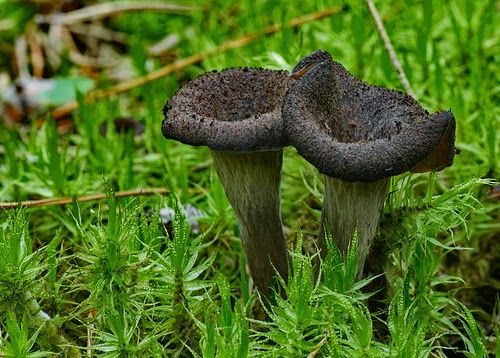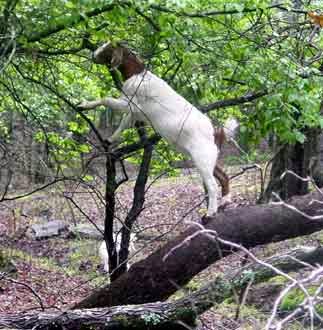Biology concepts – cornucopia, goat, nutrition, sustainability, browser/grazer, Cassandra hypothesis
It's true, goats are not native to the Americas. No, the Rocky Mountain goats (Oreamnos americanus) that grace the crags and cliff faces so majestically are not really goats, they’re actually members of the antelope family. And it turns out that they aren’t even native to the Rocky Mountains, at least not the lower Rockies. They were originally found in Alaska, and were introduced to Colorado, Montana, and South Dakota much later.
The pilgrims had at least some goats with them in 1621, they were remarked upon in one person’s journal. They certainly used them for milk and cheese at the first Thanksgiving, but they may have eaten goat meat as well. Does that sound weird to you?
O'Callaghan YC, O'Brien NM, Kenny O, Harrington T, Brunton N, & Smyth TJ (2014). Anti-Inflammatory Effects of Wild Irish Mushroom Extracts in RAW264.7 Mouse Macrophage Cells. Journal of medicinal food PMID: 25136763
Liu YT, Sun J, Luo ZY, Rao SQ, Su YJ, Xu RR, & Yang YJ (2012). Chemical composition of five wild edible mushrooms collected from Southwest China and their antihyperglycemic and antioxidant activity. Food and chemical toxicology : an international journal published for the British Industrial Biological Research Association, 50 (5), 1238-44 PMID: 22300772
As a symbol of the gifts of the Earth, the ancient Greek cornucopia (comes to us as the Latin cornu= horn, and copiae = plenty) has been adopted as a symbol of this holiday in the USA. Not every country has a specific date set aside for celebrating the harvest, but almost every culture has a version of the cornucopia.
Looking at the horn of plenty in a little more detail, we will see that it fits more nicely with the American holiday tradition, and perhaps the American future.
From Greek mythology, there are a few stories about how the horn of plenty came to be. My favorite is that when Zeus was born, he had to be hidden from his father Chronos. Dad had a nasty habit of eating his young, so Zeus was whisked away to a mountain cave on Crete where he was suckled by Almathea, a lesser god that took the form of a goat.
Zeus, being the he-man god that he was, accidentally broke off one of Almathea’s horns while playing. Of course he blamed it on his sister ….. wait, that’s what used to happen at my house. No, Zeus felt bad about his rude feat of strength, so he enchanted the horn so that it would provide Almathea with whatever she desired. I imagine that for a goat that would be anything edible, and goats will eat almost anything.
Other versions of the myth say that Almathea was a nymph that fed goat’s milk to Zeus and he subsequently blessed one of the goat’s horns to provide her with unlimited bounty as a way of thanking her – but either way it didn’t end well for for the goat. A teenage Zeus showed his appreciation by killing and skinning the goat. The skin was used to make his shield, the aegis, and is shown in many depictions of Zeus. But the horn was still around, spewing forth sustenance for the holder.
The first Thanksgiving wasn’t too much of feast; it looked nothing like the table we look over as we watch football and stuff ourselves. The pilgrims had it rough, but they were thankful for the harvest that they did manage and the wisdom that the native Americans had passed on to them about finding food in their new home.
They might have had some turkey, but they certainly didn’t have a big steak. The pilgrims had not brought any cows with them on their journey, and they weren’t native to this country. They may have had some pork, as they did have a few pigs, but they may also have had another meat – goat.
It's true, goats are not native to the Americas. No, the Rocky Mountain goats (Oreamnos americanus) that grace the crags and cliff faces so majestically are not really goats, they’re actually members of the antelope family. And it turns out that they aren’t even native to the Rocky Mountains, at least not the lower Rockies. They were originally found in Alaska, and were introduced to Colorado, Montana, and South Dakota much later.
 |
Check out the nutritional values for goat meat. If you, unlike most Americans, can stomach the idea, you should be adding it to your diet in place of some other red meat. |
True American’s don’t eat goat to any great degree. But in this instance, we’re the exception. Over 70% of all the red meat consumed worldwide is goat! I don’t remember trying it, but I am sure going to try and procure some now – not just for the novelty of it, goat meat (sometimes called chevon) is really good for you.
Chevon has greater vitamin and lower fat content than other red meats, even fewer calories and fat than chicken. People around the world haven't necessarily known about the nutritional value of goat meat for centuries; goats lived there and they ate them. Even south of the border in Mexico and Latin America they eat lots of goat (and I don’t just mean the cryptozoologic chupacabra).
All across Asia they eat goat, especially northern China, but as many of my Chinese friends say, the only thing with four legs the Chinese won’t eat is the kitchen table. Andrew Zimmern, he of the bizarre foods shows, says that goat is like soccer - it’s popular everywhere but the US.
Despite the fact that we don’t eat it nowadays, our story tells us that goat might have a bit more to do with Thanksgiving that one might think. Is there more – you bet. Along with their meager harvest and maybe some roast goat, the pilgrims enjoyed native American foods, things that were grown, hunted and/or gathered.
I have read that native American Indians didn’t eat a lot of mushrooms, but they did use them for medicines and as symbols. But the European pilgrims were certainly mushroom eaters, so it is likely they made good use of the horn of plenty mushrooms. I can see a big bowl of mushroom stuffing gracing the tables of the first Thanksgiving.
Maybe the Indians were on to something when they used the mushrooms in their medicine. Recent studies of the black trumpet mushrooms show have medicinal effects. A 2012 study indicated that several mushrooms related to, and including the black trumpet mushroom have the ability to regulate blood sugar levels so as to prevent hyperglycemia. I know my diabetic wife would be interested in that, even if she doesn’t like to eat mushrooms.
In addition to this, the same study showed that the mushrooms also have antioxidant activities. They could scavenge iron ions that can do damage to cells as well as oxygen radicals that can devastate cellular function, see this post for a discussion of oxygen radicals and antioxidants.
A newer 2014 study show that the black trumpet has significant anti-inflammatory properties. An alcohol extract of the black trumpet was able to prevent inflammatory cytokine and nitric oxide production in macrophages that were stimulated with LPS, a potent inflammatory agent.
We have seen that goat plays a role in the American Thanksgiving, perhaps in the symbol we use for the harvest, perhaps as a meat source, and even perhaps in the mushroom stuffing. Now we can see how it may represent the future as well.
So goats are better for the land, you can raise more goats on the same amount of land as cows, and you don’t need to grow as much grain for them to eat. The commercials should really be saying, “Eat More Goat.” Goat numbers in the US have doubled in the past few years, but they still pale in comparison to those of bovines. Given the nutritional and environmental advantages of goats, maybe they could use a marketing slogan – “Goat, the other green meat.” Maybe not.
All this environmental talk leads us into the last discussion for our Thanksgiving post. Is the horn of plenty really a good symbol for the Earth today? Are the resources of Earth limitless and will keep pouring forth no matter what we do to our home?
This is the issue in an argument about population growth referred to as the Cornucopia vs. Cassandra hypothesis. The cornucopia position is one that says that the Earth will be able to sustain human population no matter how much it grows, while the Cassandra hypothesis states that the Earth’s resources are limited and that uncontrolled population growth is untenable.
The argument seems odd to me. Of course the Earth can take what ever we throw at it, but we can’t. Population growth and climate change are untenable only to us. Life will change and go on, but we won’t be here to see it.
The key is to manage the growth so that we don’t destroy the Earth for ourselves and for the rest of the living organisms that we depend on. And we depend on them all in one way or another. Maybe we should give thanks that we still have time to embrace the goat. OK, that sounds bad too.
Next week - does Thanksgiving turkey really put you to sleep?
Next week - does Thanksgiving turkey really put you to sleep?
For more information or classroom activities, see:
Cornucopia in myth –
First Thanksgiving meal –
Browser versus grazer –
Cassandra and population growth –




